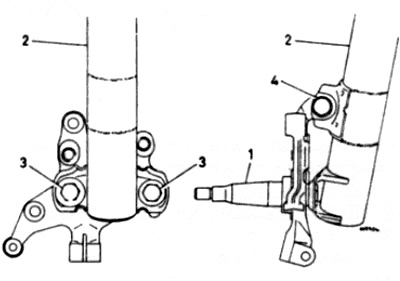Note: New top shock mount nuts, top bolt nut, and bottom shock-to-knuckle bolts are required for installation.
Removing
1. Chock the rear wheels, apply the parking brake, and jack up the front of the vehicle and securely support it on jack stands (see "Jacking up the car and placing it on stands"). Remove the corresponding front wheel.
2. If the shock absorber is to be removed, support the lower arm. Do this by placing a jack and a block of wood under the lever and lifting it up. Instead, you can compress the spring with a spring compressor (see paragraph 6).
3. Loosen and remove the two lower bolts holding the shock absorber to the steering knuckle, then remove the nut and washer. Pull out the top bolt (see fig. 5.3).

Pic. 5.3. Details of fastening of the forward shock-absorber to a rotary fist
1 steering knuckle
2 shock absorber
3 Bottom support bolts
4 Top support nut and bolt
4. Operating in the engine compartment, unscrew the nuts of the upper strut support (see fig. 5.4), then gently lower the stand down.

Pic. 5.4. Loosen the top strut nuts (shown by arrows)
Disassembly
Note: A new base plate nut will be required.
5. With the strut removed from the vehicle, clean off the dirt, then clamp it vertically in a vise
6. Loosen and remove the base plate nut while holding the shock piston with an Allen wrench (see fig. 5.6).

Pic. 5.6. Loosen and remove the top mount nut while holding the shock piston with an Allen wrench
7. Remove the nut and washer and lift the base plate and top support assembly.
8. Remove the rubber stopper from the piston, then loosen the clamp and slide the dust cover off the shock (see fig. 5.8).

Pic. 5.8. Front shock absorber parts - support assembly and parts
1 shock absorber
2 Top support plate nut
3 Recoil limiter
4 Top support
5 Upper support nuts
6 Clamp for mudguard
7 Case
8 Stem buffer
9 Washer
10 Washer
11 Body tower
9. Check if the shock absorber is leaking. Check the piston for pitting and body damage. While holding the shock vertically, check the piston movement throughout the stroke and then short strokes of 50 to 100 mm. In both cases, an even and continuous resistance should be felt. If the resistance is jerky or uneven, or there are signs of wear or damage to the shock absorber, it must be replaced.
10. Check all other details. If damage or destruction is found, replace.
11. Install the mudguard on the shock absorber. Make sure the bottom end of the cover is properly installed and secure it with the tie.
12. Thread the rubber buffer rod onto the shock piston and install the upper support.
13. Install the top support plate and washer, then install a new nut. Hold the shock piston and tighten the support plate nut to the required torque.
14. Align the top end of the mudguard with the lip on the top support base.
Installation
15 Before installation, using a tap of the appropriate size, clean the threads of the holes for the lower bolts of the shock absorber to the steering knuckle.
Advice. If you do not have the required tap, go through the thread using an old slotted bolt on the thread.
16. Install the shock absorber in place and install new top support nuts.
17. Align the steering knuckle with the shock absorber, making sure the lug on the knuckle fits into the hole.
18. Insert the upper knuckle bolt and washer, then install a new nut. Install two new lower shock absorber to knuckle bolts. Once all the bolts are in place, push the knuckle pin down hard to connect the top knuckle to the shock absorber. While holding your knuckle in this position, tighten the top bolt nut to the correct torque. Then tighten both lower bolts.
19. Remove Jack/Spring Compressor (depending on what you use) and tighten the top support nuts to the required torque.
20. Install the wheel and lower the vehicle to the ground. Tighten the wheel bolts to the required torque.
